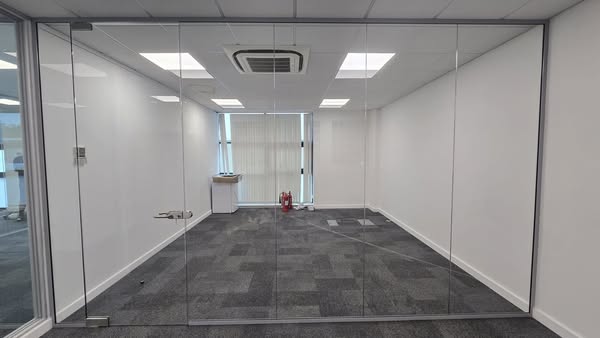
Tempered glass is trusted in high-traffic commercial spaces for a reason. It is tough, safe, and more resistant to everyday wear than standard glass. In offices, shopfronts, balustrades, doors, and meeting rooms, surface damage is more than an inconvenience. It can diminish brand image, increase maintenance costs, and shorten the lifespan of the installation.
This guide explains how scratch-resistant tempered glass really is, what causes scratches, whether surface damage can be repaired, how it compares to regular glass, and the best ways to prevent long-term wear.
What Exactly Is Tempered Glass and Why Is It So Tough?
Tempered glass is a type of safety glass that has been strengthened using extreme heat or chemical treatment to make it far more durable than standard, untreated glass. During the tempering process, the glass is heated to high temperatures and then rapidly cooled. This creates internal tension that increases its strength and makes it much more resistant to impact and sudden temperature changes.
This durability is why tempered glass is widely used in commercial spaces such as office partitions, meeting rooms, glass doors, shopfronts and balustrades. It can withstand daily contact, movement, and pressure better than regular glass, reducing the risk of cracks, chips, or breakage. Beyond strength, tempered glass is also a safer option. If it ever does break, it shatters into small, blunt pieces rather than sharp, dangerous shards.
Is Tempered Glass Scratch Resistant or Scratch Proof?
Tempered glass is scratch-resistant, but it is not scratch-proof. Its surface is harder than standard glass, which means it can withstand everyday contact from items like pens, keys or light cleaning tools. However, materials harder than glass, such as metal with sharp edges, sand particles or debris containing quartz can still leave marks.
One of the key reasons tempered glass performs better is its surface compression layer, created during the tempering process. This compressed outer surface makes it more resistant to minor abrasions and wear than regular glass.
To measure hardness, the Mohs hardness scale is used:
- Tempered glass: about 6–7
- Regular glass: about 5.5
- Sapphire glass (used in high-end watches): about 9
So while tempered glass is durable, it’s not invincible.
Scratch Resistance Comparison
| Material | Mohs Hardness Rating | Scratch Resistance Level | Typical Use Cases |
| Tempered Glass | 6–7 | Resists daily wear and minor abrasions | Office partitions, doors, balustrades |
| Regular Glass | ~5.5 | Easily scratched under pressure | Low-traffic windows, picture frames |
| Acrylic (Plexiglass) | 3–4 | Scratches very easily | Display cases, temporary partitions |
What Causes Scratches on Tempered Glass?
Even though tempered glass is built to withstand daily use, certain materials and mishandling can still mark the surface. The most common causes include:
1. Dust, sand, or construction debris: Tiny particles, especially those containing quartz, are harder than glass and can leave scratches when dragged across the surface.
2. Metal tools, keys, or fasteners during installation: Contact from tools, screws, or even belt buckles during fitting or maintenance can create visible marks.
3. Improper cleaning materials: Paper towels, rough cloths or abrasive pads can trap particles and drag them across the glass. Over time, this leads to fine, hazy scratches.
4. Sliding furniture or equipment against glass panels: Moving desks, chairs, or display units near glass walls or balustrades can cause edge scratches or surface damage.
Pro Insight: In commercial environments, regular cleaning with microfibre cloths and non-abrasive solutions is one of the simplest ways to prevent unnecessary surface wear.
Related Read: Does Tempered Glass Break
How to Prevent Scratches on Tempered Glass
These simple but effective steps help reduce surface wear in offices and commercial spaces:
1. Use non-abrasive cleaning materials: Microfibre cloths and soft squeegees are ideal. Avoid paper towels, scouring pads, or rough fabrics that contain tiny abrasive fibres.
2. Keep dust and grit under control: Particles like sand or construction debris often contain quartz, a mineral harder than glass which can scratch the surface when wiped across without proper cleaning.
3. Protect high-contact surfaces: For glass desks, partitions, or counters, use coasters, placemats, felt pads, or protective films to reduce friction from everyday use.
4. Avoid metal-to-glass contact during installation or use: Tools, screws, rings, keys, and even belt buckles can cause visible scratches if dragged across the surface.
5. Consider a protective coating: Hydrophobic or oleophobic coatings add a thin barrier that makes the glass more resistant to minor abrasions and easier to clean.
Can Scratched Tempered Glass Be Repaired or Polished?
Scratches on tempered glass can sometimes be reduced, but repair depends on how deep the damage is. Minor surface scratches may be improved using glass polishing compounds such as cerium oxide, which gently buffs the surface and makes marks less visible. However, deeper scratches that catch your fingernail or disrupt the surface layer usually cannot be fully repaired and often require glass replacement.
While professional restoration services can address light surface damage, they must work carefully. Over-polishing can remove the compressed outer layer that gives tempered glass its strength, potentially weakening it. DIY repair kits should be approached with caution for this reason. In commercial spaces, where appearance and safety matter, it’s often more practical to seek expert advice or replace panels if the scratch compromises the look or integrity of the glass.
When Should You Replace Tempered Glass?
Replacement becomes necessary when tempered glass shows damage that affects safety, function, or appearance. Deep scratches, cracks, or visible distortion are signs that the structural integrity may be compromised. Chipped edges are another concern, as they can weaken the entire panel and increase the risk of breakage.
In high-traffic environments like office partitions, meeting rooms, or glass balustrades, loss of clarity or surface wear can make glass appear old, poorly maintained, and off-brand. For many commercial clients, presentation matters; so even if the glass is still functional, scratched or visibly damaged panels are often replaced to maintain a professional, high-quality look and ensure safety isn’t at risk.
Tempered Glass vs. Frosted or Opaque Glass — Which Is Better for You?
Tempered glass offers strength, safety, and durability, but when privacy or visual softness is a priority, frosted and opaque glass provide added benefits. Frosted glass diffuses light while maintaining privacy, whereas opaque glass blocks visibility entirely and creates a more solid, defined look.
If you want both safety and privacy, tempered frosted glass is a smart middle ground; durable, elegant, and suitable for modern commercial spaces. Opaque glass, especially when tempered or laminated, works best where full privacy or stronger visual separation is needed.
Tempered Glass Maintenance Tips
1. Routine inspection for safety: Check edges, corners, and mounting points regularly for chips, pressure cracks, or loose fittings, especially on doors, balustrades, and partitions.
2. Keep hardware in good condition: Hinges, brackets, and sliding systems should be lubricated and aligned properly to prevent stress on the glass over time.
3. Monitor for stress or distortion: Look out for cloudy areas, pressure spots, or glass “bowing”, signs that the panel may be under structural stress and needs replacing.
4. Clean to preserve clarity, not just aesthetics: Stick to non-abrasive cleaners to avoid chemical damage or hazing over time, ensuring glass maintains transparency and visual quality.
5. Environmental care: Avoid exposing tempered glass to long-term moisture, extreme heat sources, or thermal shock to protect its internal compression strength.
Myths About Tempered Glass Scratch Resistance
| Myth | Fact |
| Tempered glass can’t scratch | Tempered glass is scratch-resistant, not scratch-proof. Hard materials like sand, metal tools, or construction debris can still leave marks. |
| All tempered glass is the same | The quality varies depending on the manufacturer, thickness, and whether protective coatings are applied. |
| Scratches can always be polished away | Only minor surface scratches may be reduced. Deep scratches affect the compression layer and often require replacement. |
Final Thoughts
Tempered glass is a strong, stylish, and practical choice for modern homes and commercial spaces, but like any material, it requires proper understanding and care to last. By knowing the truth about its scratch resistance, following essential maintenance practices, and investing in high-quality products, you protect not just the glass but your overall investment. Whether you’re renovating, building new, or upgrading your interiors, making informed decisions about glass installations can enhance both safety and aesthetics. If you’re considering tempered glass for your project and want expert guidance, professional installation, or premium materials, reach out to our team and we’ll bring your vision to life.
FAQs
Yes. Abrasive or ammonia-based cleaners can wear down the glass surface and create micro-scratches.
Not directly; thickness affects strength, but surface hardness stays consistent.
Yes. The matte texture of frosted glass can help conceal minor surface marks.
Oleophobic and hydrophobic coatings improve resistance to dust and light abrasions.
With proper care, it can last 20+ years without significant wear or clarity loss.
Minor scratches don’t affect safety, but deeper ones near edges can weaken structural integrity.














